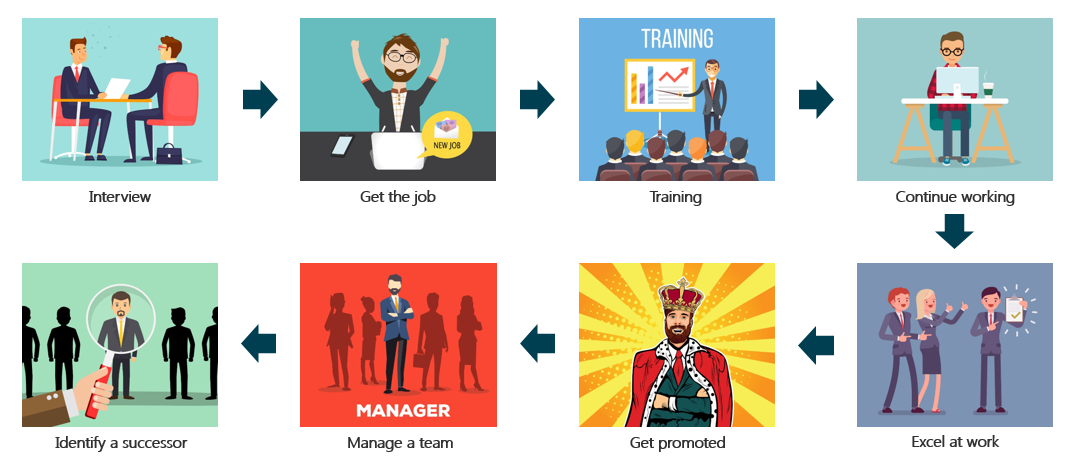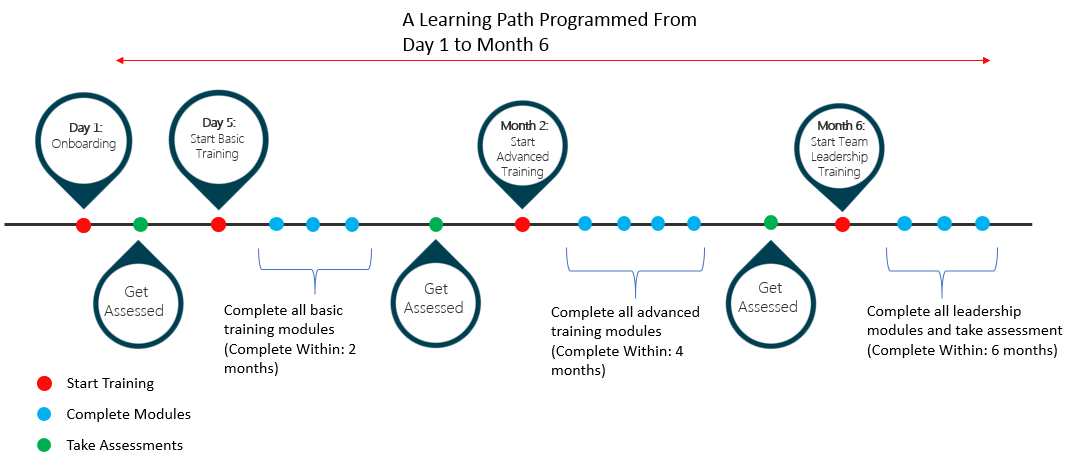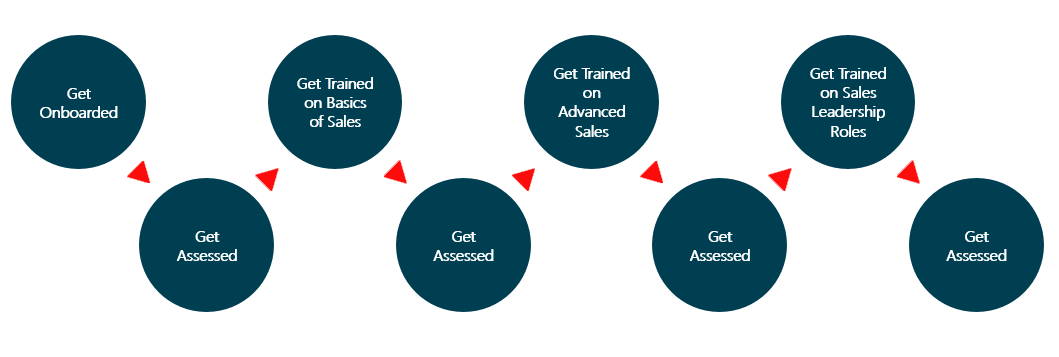The learning path feature of an LMS is an automation function which helps to plan and structure training activities. It allows the L&D team to define a job role by breaking it into specific intervals, starting with onboarding and proceeding through the entire employee lifecycle. Throughout this journey, the learning path ensures that relevant training is available to the employee to support their progress.
To understand the learning path feature, you need to first understand what an employee lifecycle is.
On this Page
An employee lifecycle within every organization looks something like this:

From interview to exit an employee grows along every interval, reaching greater heights as a result of learning new skills with time, training, and experience and find a replacement as they near the end of their employee lifecycle.
Where does the learning path feature of an LMS fit along this employee lifecycle?
The answer is—It fits along all the stages!
From start to end, the learning path feature ensures your employees are trained along the lifecycle effectively. Starting with onboarding, your LMS carries out assessments at every stage of the employee lifecycle.
Learning path identifies an employee’s current position along the employee lifecycle based on the last training module started, completed, and assessed. It then automatically presents them with the next set of training and assessment modules.
Once your employee completes all the training modules along the current learning path, the LMS gives off an indicator to the L&D team telling them that an employee is now ready to take on greater responsibilities. Based on the results from the learning path and other supporting factors, the L&D team has a better understanding of who to promote and the tangible proof to support this.
From start to end, the learning path for a specific role can last from anywhere between 3 months to 1 year. The time period keeps increasing as more training modules are added to the learning path for a specific job role.
Once created learning paths are permanently saved on your LMS. Every time someone joins your organization with that specific job role, the learning path feature automatically understands this. It then initiates your new employee and starts their learning journey.
When you’re talking about more than a handful of employees joining your organization regularly, this becomes a handy tool for an L&D. It saves them from performing the repeated task of creating an individual growth plan for every employee.
The best part, however, is that the learning path feature of an LMS charts out a detailed visual roadmap for the new employee, showing them exactly what they need to do in order to excel within the organization. It is probably one of the best ways to show your employee how they can improve their chances of success, provided they keep learning.
How to successfully implement the learning path feature?
Step 1: Map a set of skills for your employees to learn
Before setting up the learning path feature, understand and categorize the skills needed by an employee to succeed at the specific job role. Then proceed to chart exact points along the employee lifecycle that certain skills should be introduced in order to train the employee.
For example, you cannot program the learning path to train a 2-month old sales employee on how to handle a sales team. Especially before they complete the rest of the modules that lead up to such an advanced module.
Once an employee completes their basic, advanced, and professional sales training, the learning path launches advanced courses. Experience and time play an important part as well.
In this case, the learning path is ideally programmed to launch onboarding training first. The basics of sales and advanced sales then follow.
Step 2: Set minimum and maximum time intervals to start and complete a module
Learning paths are about following the employee lifecycle and providing relevant training based on the employees’ current status within the lifecycle.
A learning path is programmed to improve the management skills of employees as they near their promotion phase and not before that.
Early access results in rushed training. Moreover, programming the LP to allow learners access to a course for a limited time period ensures that the learners access and complete the course on time.
It is very important to understand the time periods after which a certain course should be made available. It is also important to specify the time limit within which to complete training. To do this, start by creating a learning path template.
Here is a learning path template:

Step 3: Provide learners with relevant training content
This has been said, repeated, and said again.
Providing learners with contextual content and not just any content to train is the key to a successful training initiative.
The pre-programmed nature of LP requires advanced content mapping. Hence, get all the training courses and modules in place. Arrange it from start to end. Upload it onto the LMS, and program the path accordingly.
Step 4: Update your learning path if the training content becomes outdated or old
Finally, update your content based on the changing training needs and the relevance of the training material. This step doesn’t have to be a regular affair. Rather, update the content when really needed.
Conclusion
- 1. Time spent at the organization
- 2. Personal relations
- 3. Performance on their previous job roles
These are three things that ruled traditional promotion strategies.
This method was inefficient and sometimes not the best. The time spent at an organization or the ability to perform as an individual are not the best-measuring yardsticks when selecting a person for an advanced job role. Effective testing and assessing are important at every stage when promoting someone.
This then gave birth to yearly assessments cycles, knowledge tests, and internal promotion programs where people competed for better positions. However, people would perform very well till they received the promotion. But, the enthusiasm to work would soon die out once they got what they wanted.
Generating detailed progress reports helps determine if an employee is ready for a promotion.
Here is a sample learning path created for a new sales employee:

Abara’s learning path feature is a great training automation tool to plan, assess, and deploy your training activity in advance. Not only does it act as a great pre-planning feature, but it also helps your employees visually see their growth trajectory within the organization, provided they dedicated time and resources towards training themselves.
We are giving out free 1-month trials of our learning path enabled LMS. Get in touch with us at contact@abaralms.com or reach out to us by submitting this form! We also develop eLearning courses! Visit eNyota Learning to know more!


